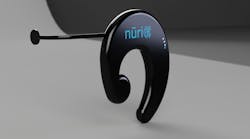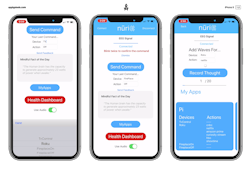Voice activated IoT devices have noticeable flaws, especially in noisy environments. A new wearable scheduled to hit the market in 2020 is offering an alternative by enabling users to control devices entirely through brain waves.
Nūrio is the world’s smallest wearable EEG device that simply slips over the ear like a headphone and provides users with app- and cloud-based command capabilities to control any IoT-enabled device integrated on the nūrio cloud using brain waves rather than voice commands. “Our goal was to package EEG electronics into small electronic housing that is comfortable to wear as opposed to some of the larger devices,” says nūrio founder and CEO Ian Rowan. “The way we made this possible was to put minimal electronics in the actual device, and instead using a supporting device whether that is a smartphone or computer connected via Bluetooth.”
How nūrio works
While leveraging the most recent EEG technology, the headphone sized device utilizes three fully shielded dry skin electrodes along with minimal on-device electronics to stream data via Bluetooth to any smart device or computer. This allows for the more powerful processors to leverage the data yielding an energy-efficient, safe and minimal wearable.
With the nūrio device users can add compatible IoT devices to their profile. And after recording approximately one minute of thoughts based on that object, nūrio’s AI algorithms can process their future waves into actionable commands. After set-up, the user can simply blink twice to trigger the device to begin recording a thought. This is then sent to nūrio servers, which process the raw wave into the user’s device, which ultimately triggers the device.
As the wearables industry continues to proliferate, nūrio believes opportunity lies in looking at data from new angles to reveal insights into what’s going on in various parts of our bodies and optimizing our health in completely new ways. The nūrio app instantly processes collected data to provide health insights as well as practical control features. “EEG also allows users to pull more health and mental activity insights in addition to controlling items by thoughts – aspects like attention, calmness and emotions,” says Rowan. “There is already a lot of science behind this using neuroscience to show people what is going on in their mental activity.”
The app also allows users to record sessions of these metrics to graph insights of attention during any focus-based task, calmness during meditation or emotions during any type of performance or experience. By leveraging machine learning, nūrio can develop baselines of the users’ mental states to help alert them to changes over time.
Market adoption and potential
Initially, nūrio is heavily focused on building its user base. However, Rowan tells IndustryWeek that they intentionally built the system to easily integrate into an array of existing processes including those within the enterprise and manufacturing environments. “From the control side, the system works with any internet connected device. If an enterprise is interested in using EEG to control actions within an existing system, the opportunity is there,” he says.
In coming months, the focus will be on finetuning the AI models it utilizes to route thoughts into commands. “The type of data we have has been based off small groups of people,” he says. “As we scale, we need to focus on constantly improving accuracy. It is somewhat unknown.”
Another key element for adoption is keeping costs down as much as possible so the technology is accessible to the general population. With the help of Protolabs’ Cool Idea Award, nūrio has been able to significantly expedite production, putting the device on-track to come to market in early to mid-2020 for under $229 USD.
Protolabs also helped manufacture the full plastic casing of the nūrio device with injection molding. In the future, nūrio will also work with Protolabs to produce its own essential electrodes via CNC machining once the design is complete. According to Protolabs Global Product Manager Gurvinder Singh, it is exciting to play a role in enabling an innovator to go from a concept, through various iterations and ultimately reach the point of hitting the market. “We helped nūrio work through various design iterations and make material choices to achieve manufacturability at a price point that allows for market adoption,” he says. “Miniaturization is always the challenge when getting a bunch of electronics into a wearable formfactor. You want to find the right fit.”
“Nūrio’s technology has the potential to completely redefine the quantified self and even tap into human capabilities that previously seemed impossible,” said Vicki Holt, President and CEO of Protolabs. “We’re proud to support such innovators who are giving people the ability to leverage their brain power in new and helpful ways.”






